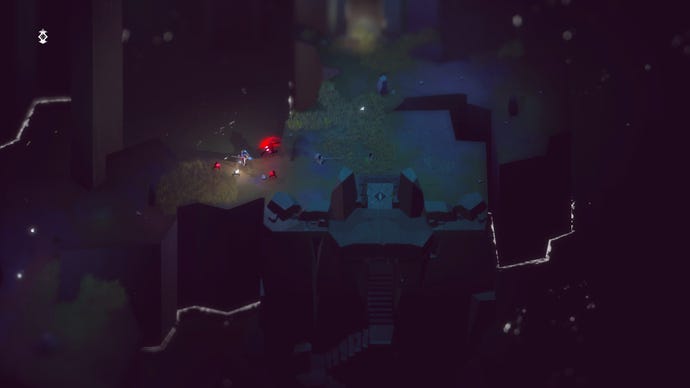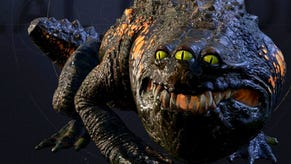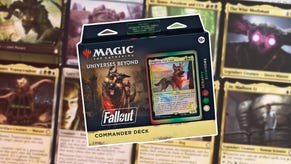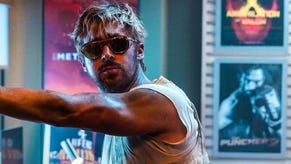Below Xbox One: Roguelike-like Meets Zelda Meets Dark Souls
Capybara Games' Below puts you on an adventure where you're really on your own. Jaz talks to creative director Kris Piotrowski about its development.
This article first appeared on USgamer, a partner publication of VG247. Some content, such as this article, has been migrated to VG247 for posterity after USgamer's closure - but it has not been edited or further vetted by the VG247 team.
At last week's Microsoft Spring Showcase, I had the opportunity to play Capybara's upcoming Xbox One title, Below, and talk to creative director Kris Piotrowski about the game.
Approaching Below for the first time is an interesting experience. It's an arcade adventure viewed from a top-down perspective that offers no clues as to what to do or where to go. Your tiny character is basically dropped into the game's very dark environment, and you have to figure out everything from there on, from what your character is capable of doing to what the overall objective is. It's slightly unsettling at first, but once I made the conceptual leap that Below was going to offer me no help or guidance, I began to enjoy delving into its mysteries.

It turns out that this a deliberate part of its design. Kris explains, "At its core, Below is a roguelike, but it's also a bit of an adventure game as well. The two main wells it's pulling from are traditional Zelda design – Windwaker in terms of combat and feel – and classic roguelike sensibilities. It does have permanent death, and parts of the game world are randomly generated after death. There's also a little bit of the roguelike style – the concept of not really knowing how anything works, and being able to enter the world and experiment and learn through failure, and build up your knowledge of the game systems and mechanics as you go."
"The game is called Below because it's about going down into a world. It takes place on a single isle in the middle of the ocean, and the majority of the game takes place in its interior. You begin on the surface of the isle, and there's just one door that leads you into the interior of the isle and the level flow. The main driving force is questions like: What's down there? What is this island? What's the purpose of this place? Why did this wanderer get drawn there?"
Kris continues, "I think there's a resurgence of interest in games that don't hold players' hands. There was an era when game development went a bit too far into the guiding and handholding – the early to mid-00's AAA development where we forgot that players actually do enjoy sitting down and figuring things out. I think Below will appeal to those who are interested in sitting down with a game that puts everything in their hands – this is up to you, so go figure it out, and good luck."
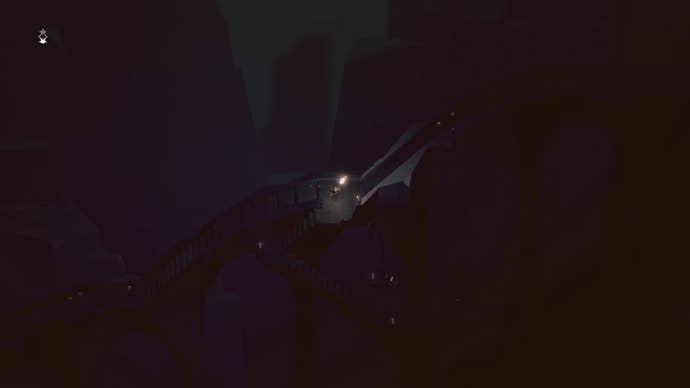
"I'm also a really big fan of games that are maybe not necessarily intentionally designed to do this, but they do, but they can galvanize a community to help people get through them and find things and reveal secrets and strategies. Players are really good at dissecting games, no matter how convoluted or strange your puzzle and system design is. What I hope happens is that Below comes out, and people will enjoy not knowing anything about it, and that will hopefully facilitate discussions about it. The Dark Souls series is really good at that. I remember when that first came out, and everyone at the studio was playing it, and we were talking to each other about it in the same way that we used to in grade school about a Zelda game. Where to get a certain item, or how to beat a certain boss, and stuff like that. Dark Souls really did that well."
As I continue to play the game and work my way into the island's interior, I stumble across a spike trap that kills me instantly. I start a new game, having learned my lesson the hard way. I ask Kris about the challenges of balancing frustration and discoverability in a game like this.
He responds, "There's definitely been a balance between how vague and convoluted can we go – how little we can hint about something. So we're trying to walk a line where the game is approachable and decipherable, but ideally what we want is a game where over time players will be able to understand everything about it."
"The way I look at it is, when Below comes out, I think that there's going to be a brief moment when nobody knows anything about it, but then within the first day there'll be people who finish it, and other people who will be filling wikis with information. There's going to be just a short period of time when you really don't know what's in the game. That's just players doing what they do."
"I think there's an initial difficulty spike at the start, but over time, and with your own play and own experimentations and just learning through things like stepping on the wrong trap, and figuring out strategies for enemies in combination with chatting with your friends and checking on Twitter, it'll fill in the additional info. I'm confident that the community will come through. Gamers are incredible problem solvers, and they're also super-devoted. It might be wishful thinking, but that's what I hope."
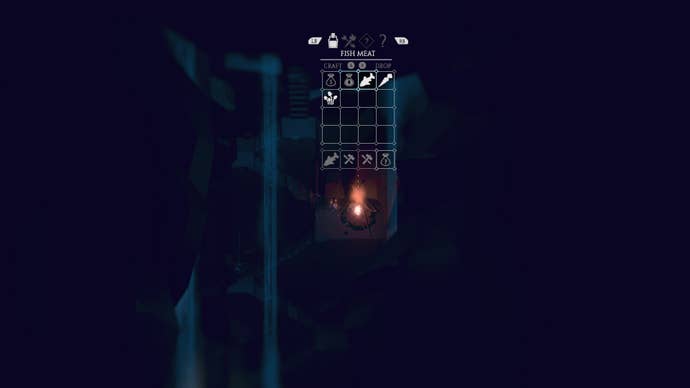
While I explore the game's environment, I come across a lot of items that I can pick up and put into my backpack. I assume they have a use. Kris nods, "You have a backpack with four tabs, and you can do things like craft soup if you're sitting by a fire. So if you have your backpack full of edible ingredients and a bottle of water, for example, you can put water into a pot and add ingredients to make a soup. Soups are the game's potions and they give different buffs and health benefits. Soups also provide warmth. One of the mechanics of the game is that the deeper you get into it, the colder it gets. So managing hunger, thirst, temperature, and light are pillars of that whole system."
"You can also make tools like arrows, torches, bandages and things like that. We've been trying to make it so that everything in the game is as minimal as possible. It's not like Fallout 4, but it's definitely a support system. Your ability to get deeper into the world has to do with your combat skills, your knowledge of the world, and your knowledge of the flora and fauna of the world and knowing what you can make at any given moment from the things around you."
One of the unique features of Below is its art direction. It feels very clean, minimal and stylized, and incorporates a tilt-shift photography effect that makes the game environment feel almost like a miniaturized model. I ask Kris to talk about the origins of this.
"One of the earliest concepts that led to Below was that we had this idea to make a game that used a single HD screen in a different way that let you zoom the camera out so that each screen was essentially one level of the game, and you were just a speck on the screen. When we committed to that, the idea of tilt-shift came almost immediately after that. Once we decided to go small scale, it made sense to use tilt-shift to make it feel even smaller and more strangely miniaturized. It's like you're looking at a tiny, miniature play set.
"The other thing is that the blurring tilt-shift effect is a useful part of the game design because in a game where you can essentially see the whole level, the player still has a reason to move from one part to another because they can't see everything on the screen, because the elements are obscured. You'll need to walk over to it to be able to see what it actually is. Even though you can see the whole screen, you don't necessarily see it all."
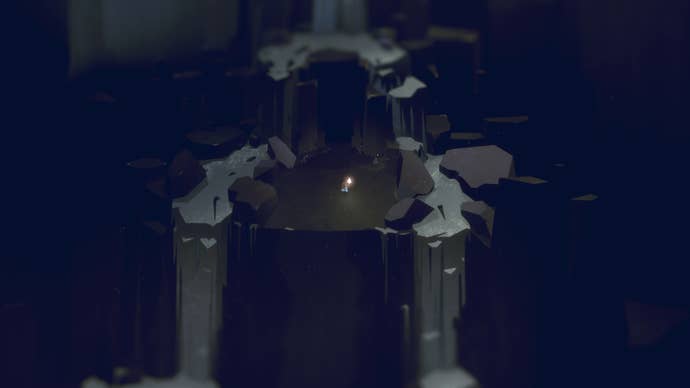
Since Kris mentioned early concepts, I'm intrigued to know how Below developed over time. He reveals, "The game has been in development for four years. It started off as a prototype that Ken Young and I put together with Tony Chan. Tony is one of the founders of Capy, and the art director of Below, and Ken is the lead designer and the lead programmer of Super Timeforce. Somewhere in between that, we made this initial demo of the game to prove that the scale would work. From that, we started actual development, but at the same time we also made Super Timeforce."
"It hasn't been an easy project. We decided to do all the hard things. When you zoom out as far as you can in Below, that creates a whole bunch of problems that you have to figure out in terms of priority. Coming up with the aesthetic was difficult, and refining that has been a challenge. We've never done a randomly-generated game, and this is the first time we've done a 3D game. There are parts of the game that are 2D, but the majority of it is 3D, so we had to figure that out. The reality is that Below is the largest and most complex game we've made mechanically and conceptually."
"We always try to go out into the wilderness with development. We spend a lot of time with every game we make trying different things to find the game, and then we throw a lot of stuff away and focus in on what's successful at the end. That's our weird development style. With Below, it's a type of game that has many different possibilities to explore, and we've just tried to explore them all. It's a complex, long video game with lots of moving parts. No game we've ever made has been easy to make, and this one just happens to be the biggest and craziest."

"It's been a long project, but I'm still in love with it. And it's never looked or played better, so I think we're really pushing towards the finish line. When you're in exploration mode, there are lots of times when you're going in the wrong direction or moving sideways or backwards. A lot of development was figuring out what worked, and the nature of that always takes time."
"Making a great game is very hard," adds Kris with a grin.
With that, I finish up playing my demo of Below. My experience with the game was definitely an interesting one. While I initially found the game somewhat frustrating to play – especially getting killed without warning – understanding its conceptual nature really changed my opinion. This is an exploration game in the truest sense of the word, and there's a real element of discovery that I enjoyed, once I realized I was on my own and that the game wasn't going to offer me any help. Messing around with ingredients to see what I could make, and experimenting with the Zelda-like combat system was fun, and I really felt like I was on an adventure into the unknown.
Below is unlike anything I've played recently, and I'm looking forward to getting the chance to delve into it further when it’s released later this year.
